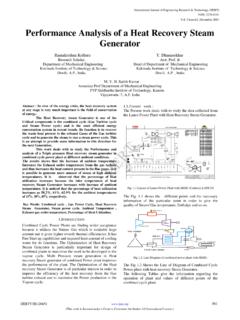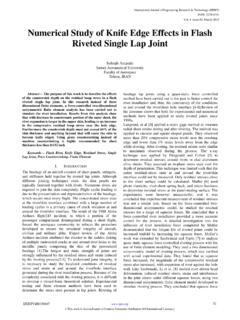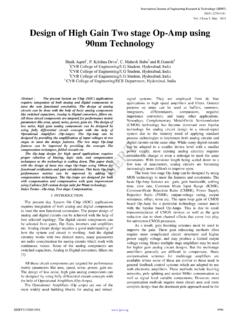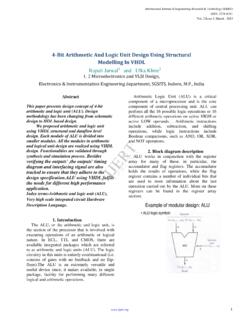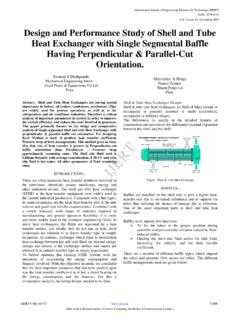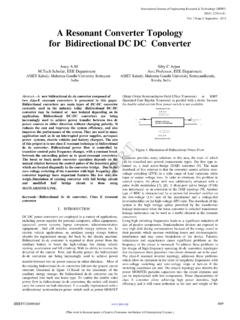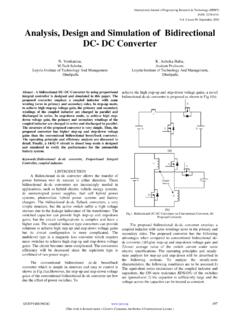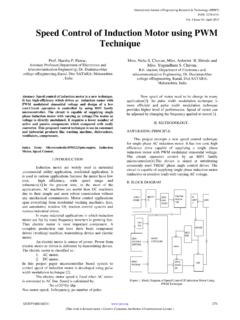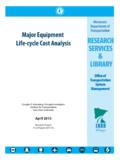Transcription of Product Life Cycle And Marketing Management Strategies
1 Product life Cycle And Marketing Management Strategies Milind Kamthe, Dr. Devendra Singh Verma, Department of Mechanical Engineering, Institute of Engineering & Technology, DAVV Indore Abstract A company s positioning and differentiation strategy must change as the Product , market and competitors change over the Product life Cycle (PLC).In this stage of rapid change, every organization wants the Product to enjoy a long and happy life by improve their Product process and systems. The understanding of a Product s life Cycle and Marketing Strategies can help an organization to understand and realize when it is time to launch and withdraw a Product from market. Thus, the purpose of this paper is to understudy the Product life Cycle and its Marketing Management Strategies . A lot of factors were accounted for, and importance of Marketing Strategies and Product life Cycle highlighted.
2 The paper further takes a look at various concepts of Scholars on Marketing Management Strategies . Finally, the study shows that the value of Marketing Strategies and when products move through their life Cycle process, different Marketing Management Strategies are developed and applied as appropriate. Introduction The concept of a Product life Cycle has occupied a prominent place in the Marketing literature, both as forecasting tool and a guideline foe corporate Marketing strategy. In its simplest form, it serves as a descriptive model of the stages of market acceptance of a Product . There are several factors which can and do affect Product s life Cycle in the market such as customer s needs, competition, new technologies and other aspects of Marketing environment. A firm s competitiveness is increases through effective Product and Marketing strategy which involves production of a variety of products and successfully Marketing them.
3 The deep knowledge of Marketing Management is most essential to improve products life Cycle . In this paper I will try to present issues relating to the Product life Cycle as well as Marketing Management Strategies as applied in each stage of Product life Cycle . Such discussion will help the organizations to develop effective Strategies and successfully manage a Product s life Cycle . What is Product and Product life ? Basically, a Product is the object of the exchange process, the thing which the producer or supplier offers at a potential customer in exchange for something which the supplier thinks as equivalent or of greater value. The Product is an important component of the Marketing mix. A Product is anything that can be offered to a market to satisfy a want or need. It includes goods, services, experiences, events, persons, place, properties, organizations, information and ideas.
4 Schewe and Smitch (1980:224) recognized the traditional expanded approaches to defining a Product . Under the traditional approach , a Product is seen as the entire bundle of utility that is offered by a marketer to the market place. This bundle contains a potential for satisfaction that comes in part from a tangible, objective feature of the Product . Satisfaction is also derived from the intangible, subjective features of a Product . Nwokoye (1981:95) sees a Product as a bundle of physical and psychological satisfaction that a buyer receives from a purchase. This includes not only the tangible object, but also such supportive elements as packaging convenience of purchase, post purchase services and others that buyer s value. New products may lead to sales growth or stability, increase profits control, reduce risk through diversity, offer differential advantages, improve distribution and respond to consumer needs.
5 Those products which ultimate users buy for their final consumption are called consumer products, while those bought for resale or for producing other items intended for sales are industrial products. 2035 International Journal of Engineering Research & Technology (IJERT)Vol. 2 Issue 4, April - 2013 ISSN: Product life - The definition of Product life is context dependent as well as user-dependent, , for a customer the Product life is the period of time that she/he uses it( from purchasing until it is disposed of). In contrast to this, the Product life is normally longer for the producing compony; it starts with the ideas of a Product and concludes with the end of the production with the end of the service period for the Product (Sendler2009). The Product life Cycle (PLC) The Product life Cycle is the period of time over which an item is developed, brought to market and eventually removed from the market.
6 It is an important tool for analysis and planning of the Marketing mix activity. According to Wells et al.(1995:96), Product life Cycle is based on a metaphor that treats products as people and assumes they are born (introduction) ,develop (grow), age (mature), and die (decline). To Morden (1991:240), the Product life Cycle represents recognition of the fact that most products will only have a finite market life - be it short as in the case of fashion goods or long as in the case of certain type of industrial equipment. Kotler (2000:303) see the concept as implying the following: 1. Products have a limited life . 2. Product sales pass through distinct stages, each posing different challenges, opportunities, and problems to the seller. 3. Profits rise and fall at different stages of the Product life Cycle . 4. Products require different Marketing , financial, manufacturing, purchasing, and human resources Strategies in each life Cycle stages.
7 The Product life Cycle is the concept that a Product goes through several stages in the course of its life : 1. Product development stage. 2. Product introduction stage. 3. Product growth stage. 4. Product maturity stage. 5. Product decline stage. Source: William D. This Cycle varies according to industry, Product , technology, and market. The Product life Cycle is divided into 5 stages: 1. Development stage: The development stage of the Product life Cycle occurs when a corporation finds and develops a new Product idea. A Product is generally undergoing several changes involving a lot of money and time during development, before it is exposed to target customers via test market. At this stage, sales are zero and revenues are negative. 2. Introduction stage: The introduction stage of the Product life Cycle occurs when a Product is first introduced to its target market. Large expenditure on promotion and advertising is common.
8 A corporation must be prepared to spend a lot of money and get only a small proportion of that back. At this stage, sales are low, production costs tend to be high and profit is negative or very low. 3. Growth stage: The growth stage of the Product life Cycle occurs when demand for the new Product starts increasing rapidly. This is the right time to focus on increasing the market share because innovators move from the trial to repeat purchase if they are satisfied with the Product though innovators may influence others by word of-mouth, which is often considered the most effective mode of communication. A new growing market alerts the competition s attention. At this stage, sales are rise, revenues increase and profit rise. 2036 International Journal of Engineering Research & Technology (IJERT)Vol. 2 Issue 4, April - 2013 ISSN: 4. Maturity stage: The maturity stage of the Product life Cycle occurs when demands have reached its planned or unplanned peak, and the percentage that it s ever going to buy the Product has been reached.
9 This stage of life Cycle is the longest phase for most products. Competition is most intense during this stage. At this stage, sales reach peak, and market share may be high. 5. Decline stage: The decline stage of Product life Cycle occurs when sales continue a strong downward drift and profits erode rapidly toward the zero point. The typical reason for a Product decline is the entry of new products coupled with decreases consumer interest in specific Product . What is Marketing ? According to American Marketing Association, Marketing is the process of planning and executing the conception, pricing, promotion, and distribution of ideas, goods, service to create exchanges that satisfy individual and organizational goals. Kotler1980, Marketing is the human activity directed at satisfying human needs and wants through an exchange process. While kotler1991, Marketing is a social and managerial process by which individuals and groups obtain what they want and need through creating, offering and exchanging products of value with others.
10 According to The Chartered Institute of Marketing , Marketing is the Management process that identifies, anticipates and satisfies customer requirements profitably The core Marketing concepts is: 1. Target markets and segmentation. 2. Marketplace, market space and metamarket. 3. Needs, wants and demand. 4. Marketers & prospects. 5. Product offering and brand. 6. Value and satisfaction. 7. Relationship and network. 8. Marketing channels. 9. Supply chain. 10. Competition. 11. Marketing environment. 12. Marketing program. Marketing Mix The Marketing mix is the set of Marketing tools the firm uses to pursue its Marketing objectives in the target market. McCarthy classified these tools into four broad groups that he called the four Ps of Marketing : 1. Product - The Product (or service) that the customer obtains 2. Price- How much the customer pays for the Product ? 3. Place- How the Product is distributed to the customer.
